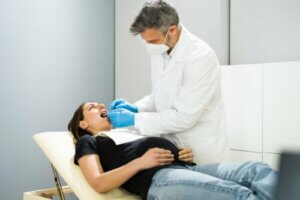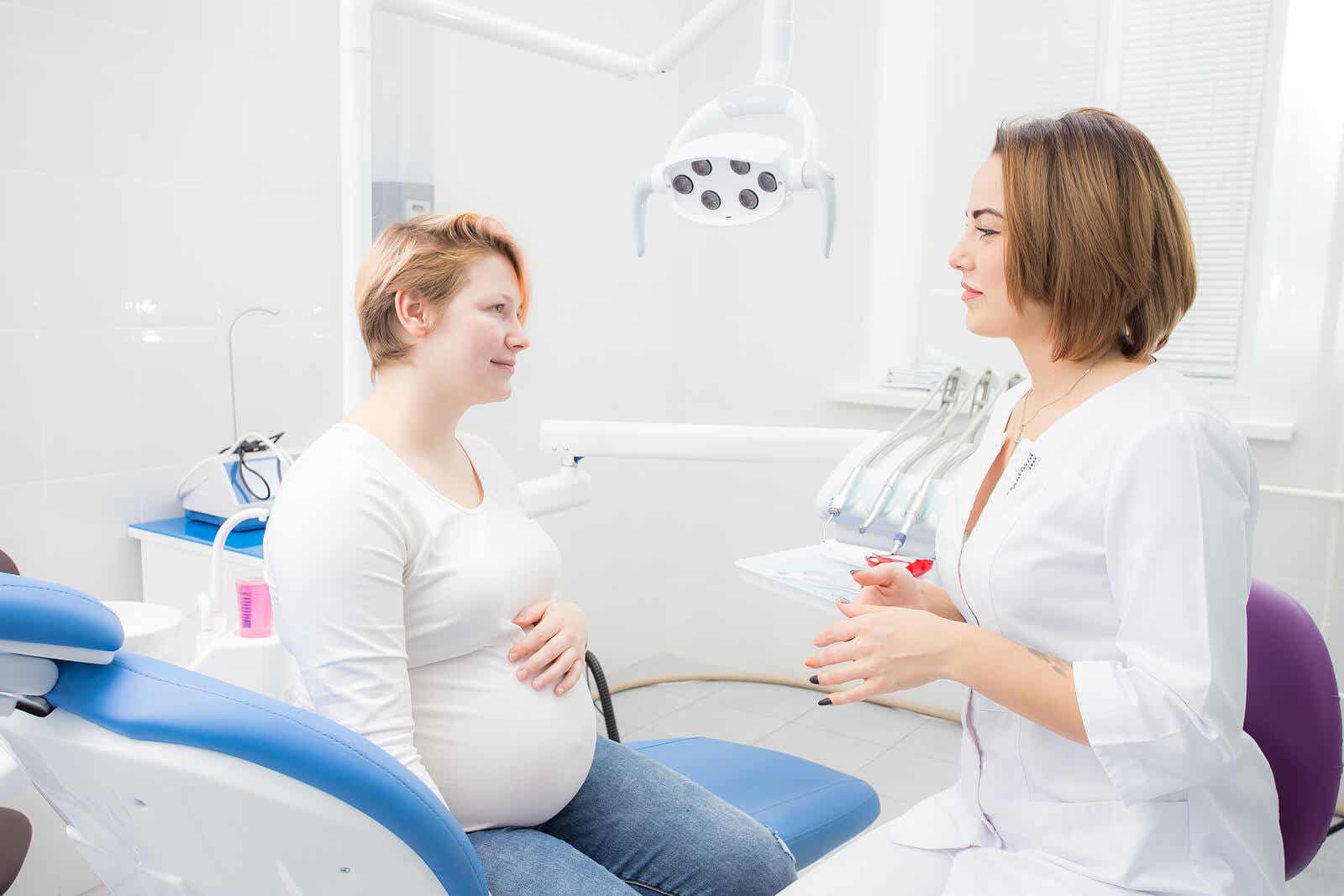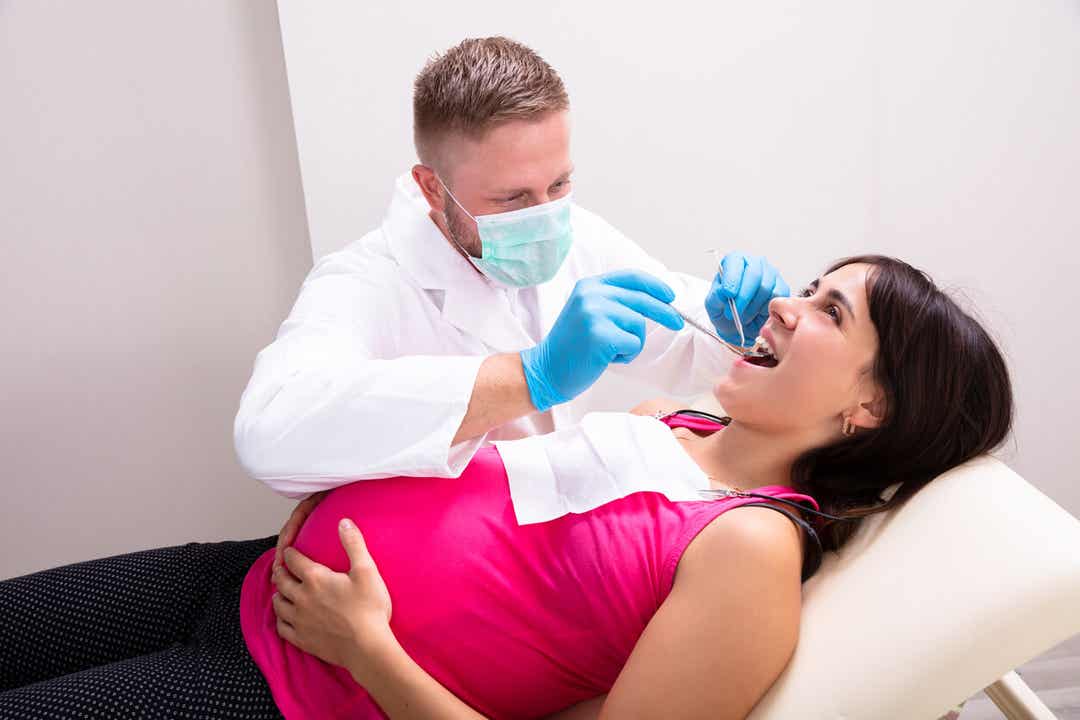Can I Get Dental Fillings While Pregnant?

Knowing if it’s possible to get dental fillings while pregnant is a very common doubt among expectant mothers. Pregnant women are often afraid to go to the dentist because they believe that no procedure is safe during this stage.
The truth is that it’s actually necessary to visit a dental professional during pregnancy in order to avoid complications. The dentist checks the state of your mouth, performs cleans, applies fluoride, and determines if there’s a need for any specific treatment.
In addition, the dentist will give advice on specific care during this period in a woman’s life. And, if any intervention is necessary, the dentist will advise the mother-to-be on the best time to do it. Keep reading to find out what happens with dental fillings while pregnant.
The importance of seeing a dentist during pregnancy
As we already mentioned, going to the dentist is vital for the care of the mouth during pregnancy. The professional will determine the needs of the case and, depending on these, treatments will be performed at the most appropriate time.
Sometimes, it’s necessary to control certain conditions and make definitive treatments once the pregnancy’s over. Other times, it’s best to solve simpler situations in time to avoid complications or complex therapies in the future.

This frequent problem consists of the loss of minerals from the teeth. It starts out looking like a simple stain but, as it progresses, it destroys the structure of the tooth. Without proper treatment, cavities can cause pain and infection.
Is it safe to get dental fillings while pregnant?
Fillings can be useful in treating decayed teeth. They consist of removing the damaged tissue and replacing it with an artificial material that restores form and function to the tooth.
Tooth fillings during pregnancy are simple treatments that a dentist can perform safely. This therapy doesn’t affect either the fetus or the mother. Therefore, with this simple intervention, it’s possible to control active cavities. If these aren’t resolved, they can evolve into infections or intense pain that alter the pregnancy. These complications can include the onset of contractions, premature births, or low birth weight babies.
What to take into account when getting dental fillings during pregnancy
When going to the dentist, the pregnant woman should always inform or remind the dentist of her condition. The dentist will take various factors into account in order to determine the type of treatment they’ll perform. These include the length of gestation, the mother’s state of health, and the needs of the mouth.
Although, as mentioned above, fillings are a safe treatment during pregnancy, there are certain considerations that dentists usually take into account. These are as follows:
- Timing: the second trimester is the ideal time for tooth fillings during pregnancy. At this stage, nausea, vomiting, and the time of formation of fetal organs have already passed. Therefore, in the first three months of pregnancy, only urgent, unpostponable procedures should take place. After the third month, the mother will be more comfortable on the chair, as her belly hasn’t yet grown too much. In the last trimester, long periods of sitting in the same position plus the weight and size of the belly can make the process difficult.
- Anesthesia: the use of local anesthesia at low doses doesn’t harm the fetus. In cases of underlying disease or disorders associated with pregnancy, the dentist will choose a milder drug or one without vasoconstrictors to avoid complications.
- X-rays: in general, they’re not necessary for this type of procedure. However, if they’re unavoidable because the professional considers it necessary, the doses of radiation dentistry uses aren’t harmful to the fetus. In any case, the professional should place a lead shield over the abdomen and use the smallest possible amount. Doctors should avoid orthopantomography, which are X-rays of the jaws with much higher exposure.
- Avoid amalgam fillings: although there’s not enough evidence to prove that amalgam is harmful to the fetus, it’s not used during pregnancy. These restorations are made with an alloy of silver and mercury, and it’s this last element that should be avoided during pregnancy. The dentist has other safer and more esthetic materials to restore the teeth.

Oral health during pregnancy is fundamental
We’ve already mentioned that the changes inherent to pregnancy can predispose women to suffer from diseases in the mouth. Oral health care is essential to avoid discomfort and more serious consequences.
Brushing teeth and gums three times a day with a soft bristle brush and fluoride toothpaste is vital in order to eliminate bacterial plaque. This should be complemented with the use of dental floss. Pregnant women shouldn’t neglect these steps, even if they experience gagging or sensitivity, as the accumulation of bacteria in the mouth worsens conditions.
A healthy, balanced, and varied diet should also be taken into account. Foods high in sugar should be avoided, as they’re not only unhealthy but also promote the development of cavities.
It’s also necessary to visit the dentist frequently during pregnancy. One visit per trimester is recommended, although you should consult immediately in case of an emergency. Going to the dentist with confidence and following their recommendations allows pregnant women to keep their mouths healthy during this important stage.
Knowing if it’s possible to get dental fillings while pregnant is a very common doubt among expectant mothers. Pregnant women are often afraid to go to the dentist because they believe that no procedure is safe during this stage.
The truth is that it’s actually necessary to visit a dental professional during pregnancy in order to avoid complications. The dentist checks the state of your mouth, performs cleans, applies fluoride, and determines if there’s a need for any specific treatment.
In addition, the dentist will give advice on specific care during this period in a woman’s life. And, if any intervention is necessary, the dentist will advise the mother-to-be on the best time to do it. Keep reading to find out what happens with dental fillings while pregnant.
The importance of seeing a dentist during pregnancy
As we already mentioned, going to the dentist is vital for the care of the mouth during pregnancy. The professional will determine the needs of the case and, depending on these, treatments will be performed at the most appropriate time.
Sometimes, it’s necessary to control certain conditions and make definitive treatments once the pregnancy’s over. Other times, it’s best to solve simpler situations in time to avoid complications or complex therapies in the future.

This frequent problem consists of the loss of minerals from the teeth. It starts out looking like a simple stain but, as it progresses, it destroys the structure of the tooth. Without proper treatment, cavities can cause pain and infection.
Is it safe to get dental fillings while pregnant?
Fillings can be useful in treating decayed teeth. They consist of removing the damaged tissue and replacing it with an artificial material that restores form and function to the tooth.
Tooth fillings during pregnancy are simple treatments that a dentist can perform safely. This therapy doesn’t affect either the fetus or the mother. Therefore, with this simple intervention, it’s possible to control active cavities. If these aren’t resolved, they can evolve into infections or intense pain that alter the pregnancy. These complications can include the onset of contractions, premature births, or low birth weight babies.
What to take into account when getting dental fillings during pregnancy
When going to the dentist, the pregnant woman should always inform or remind the dentist of her condition. The dentist will take various factors into account in order to determine the type of treatment they’ll perform. These include the length of gestation, the mother’s state of health, and the needs of the mouth.
Although, as mentioned above, fillings are a safe treatment during pregnancy, there are certain considerations that dentists usually take into account. These are as follows:
- Timing: the second trimester is the ideal time for tooth fillings during pregnancy. At this stage, nausea, vomiting, and the time of formation of fetal organs have already passed. Therefore, in the first three months of pregnancy, only urgent, unpostponable procedures should take place. After the third month, the mother will be more comfortable on the chair, as her belly hasn’t yet grown too much. In the last trimester, long periods of sitting in the same position plus the weight and size of the belly can make the process difficult.
- Anesthesia: the use of local anesthesia at low doses doesn’t harm the fetus. In cases of underlying disease or disorders associated with pregnancy, the dentist will choose a milder drug or one without vasoconstrictors to avoid complications.
- X-rays: in general, they’re not necessary for this type of procedure. However, if they’re unavoidable because the professional considers it necessary, the doses of radiation dentistry uses aren’t harmful to the fetus. In any case, the professional should place a lead shield over the abdomen and use the smallest possible amount. Doctors should avoid orthopantomography, which are X-rays of the jaws with much higher exposure.
- Avoid amalgam fillings: although there’s not enough evidence to prove that amalgam is harmful to the fetus, it’s not used during pregnancy. These restorations are made with an alloy of silver and mercury, and it’s this last element that should be avoided during pregnancy. The dentist has other safer and more esthetic materials to restore the teeth.

Oral health during pregnancy is fundamental
We’ve already mentioned that the changes inherent to pregnancy can predispose women to suffer from diseases in the mouth. Oral health care is essential to avoid discomfort and more serious consequences.
Brushing teeth and gums three times a day with a soft bristle brush and fluoride toothpaste is vital in order to eliminate bacterial plaque. This should be complemented with the use of dental floss. Pregnant women shouldn’t neglect these steps, even if they experience gagging or sensitivity, as the accumulation of bacteria in the mouth worsens conditions.
A healthy, balanced, and varied diet should also be taken into account. Foods high in sugar should be avoided, as they’re not only unhealthy but also promote the development of cavities.
It’s also necessary to visit the dentist frequently during pregnancy. One visit per trimester is recommended, although you should consult immediately in case of an emergency. Going to the dentist with confidence and following their recommendations allows pregnant women to keep their mouths healthy during this important stage.
All cited sources were thoroughly reviewed by our team to ensure their quality, reliability, currency, and validity. The bibliography of this article was considered reliable and of academic or scientific accuracy.
- Alfaro Alfaro, Ascensión, et al. “Embarazo y salud oral.” Revista Clínica de Medicina de Familia 11.3 (2018): 144-153.
- Calderón, Yeniffer Anyosa, et al. “Mitos y evidencias en odontología sobre la gestación.” Revista Científica Odontológica 7.1 (2019): 113-120.
- Rodrigues, Fábio, et al. “Anestesia local em gestantes na odontologia contemporânea/Local anesthesia in pregnant women in contemporary dentistry/La anestesia local en mujeres embarazadas en la odontología contemporánea.” Journal Health NPEPS 2.1 (2017): 254-271.
- Pazmiño Rojas, Karina del Cisne. Conocimiento sobre el manejo farmacológico de mujeres embarazadas en docentes de la Facultad Piloto de Odontología. BS thesis. Universidad de Guayaquil. Facultad Piloto de Odontología., 2019.
- Curiel Álvarez, Andreina, and Diana Dorta. “Abordaje clínico odontológico de la mujer embarazada. Revisión de la literatura.” (2019).
- Guzmán Téllez, Miguel Ángel, and Rafael Palencia Díaz. Manual de terapéutica odontológica. Editorial Pontificia Universidad Javeriana, 2019.
- Aldana Curay, Karla Belen. “Prevalencia de caries dental en gestantes entre el segundo y tercer trimestre de gestación atendidas en el Centro de Salud Comunidad Saludable. Sullana 2018.” (2020).
- Altamirano, Carla Andrea Arias, and Fadya Orozco. “Conocimientos, actitudes y prácticas de embarazadas en control prenatal relacionadas con salud oral y embarazo, de mujeres que acuden a consulta externa del Hospital Gíneco Obstétrico Isidro Ayora.” Odontoinvestigación 3.1 (2017).
This text is provided for informational purposes only and does not replace consultation with a professional. If in doubt, consult your specialist.








